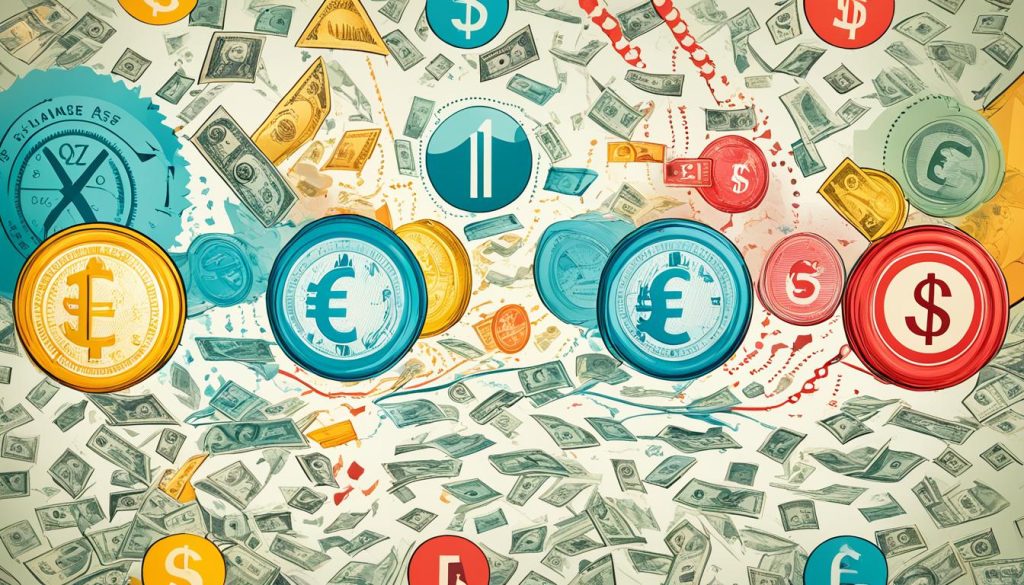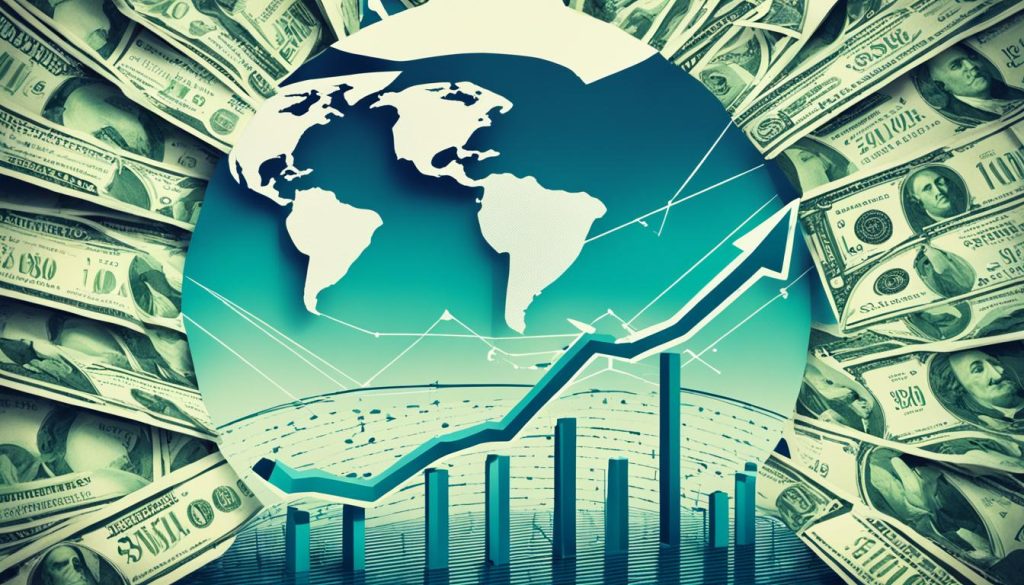Exchange rates are essential for any country’s economy. They affect how we trade with other countries and the value of investments. This means they can make imports cheaper or more expensive. It also impacts how competitive our exports are abroad.
A strong currency can lead to lower costs for importing goods. However, it might make our exports cost more for others. This could be bad for how much we sell overseas. Keeping an eye on exchange rates is important for governments and experts. This is because they can show how well a country’s economy is doing.
Things like inflation and interest rates help decide exchange rates. So do other factors like how much debt a country has and its trade deals. This shows how different parts of the economy work together. They affect how valuable our currency is compared to others.
Key Takeaways:
- Exchange rates significantly influence international trade relationships.
- A valuable currency makes imports cheaper but exports pricier.
- Inflation rates, interest rates, and public debt are key economic health indicators.
- Governments and analysts monitor currency movements to gauge economic performance.
- Complex economic factors interrelate to determine currency value.
Introduction to Exchange Rates
Understanding exchange rates is key to get how global trade works. They determine how much international goods cost and affect businesses and travellers alike. Changes in these rates can impact a country’s economy and its place in world trade.
Definition of Exchange Rates
Exchange rates show how much one currency is worth in another. For example, the cost in pounds to buy a dollar or euro. They’re central in global trade, affecting how we price items from different countries. A strong currency can signal a healthy economy, while a weak one might suggest troubles.
Importance of Exchange Rates in Global Trade
Exchange rates are more than just about changing money. They play a part in currency valuation. This can make imports cheaper or more expensive. For companies, a good exchange rate can mean success or failure overseas. Authorities and analysts keep an eye on them to help the economy stay on track.
- They keep imports affordable and exports competitive.
- They influence what we spend on holidays and business investments.
- They show how well a country’s economy is doing.
Factors Influencing Exchange Rates
Exchange rates play a big role in the world economy. They change because of many things. It’s important to know what affects them to understand currency and trade.
Inflation Differentials
Inflation differences are key in setting exchange rates. A country with low inflation sees its currency value go up compared to others. This happens because its money buys more, making it more sought after globally.
This makes goods cheaper for other countries, increasing demand for the strong currency. So, a good grip on inflation can improve trade.
Interest Rate Differentials
Interest rates also matter a lot for currency value. High interest rates attract investors looking for more profit. This makes the currency stronger as more people want it.
On the flip side, low interest rates can make a currency weaker. Fewer investors are interested, affecting trade and the economy’s balance.
Current Account Deficits
A current account deficit means a country spends more on foreign trade than it earns. This pushes a currency down. Understanding this balance is important as it shows a country’s financial state.
If deficits keep happening, the currency might weaken. This affects the country’s economy and its trade with others.
The Role of Inflation in Exchange Rates
Inflation greatly affects a currency’s value on the global market. Lower inflation leads to stronger currency because it shows good economic health. Countries with lower inflation attract more investors, making their currency stronger.
On the other hand, high inflation often lowers a currency’s value. It suggests weak purchasing power and might highlight economic troubles. Countries with stable, low inflation see better exchange rates, unlike those with high inflation.
Understanding the link between inflation and currency exchange is crucial. It helps investors and policymakers foresee changes in exchange rates. They use inflation trends to assess economic health and purchasing power.
The Impact of Interest Rates on Currency Values
Interest rates are key in setting a currency’s value. Central banks adjust these rates to manage inflation and the economy. We’ll look at how these policies can make a currency stronger and draw in foreign investors.
How Central Banks Influence Exchange Rates
Central banks like the Bank of England play a big role in the forex market. They change interest rates to control the economy. Raising rates boosts a currency, attracting investors who want more returns. Dropping rates can weaken a currency’s appeal.
Interest Rate Manipulations and Their Effects
Changing interest rates do more than affect currency strength. To slow down fast inflation, banks can hike rates. This cools the economy and stabilises prices. Cutting rates boosts borrowing and spending, prompting growth. Such moves by central banks shape how investors see an economy.
The link between interest rates, bank policies, and currency strength is complex. It shows how monetary policy and investment choices are deeply connected.
Current Account Balances and Exchange Rate Movements
The current account balance shows the trade difference between a country and its partners. It is key in determining exchange rate movements. A positive trade balance means a country earns more from exports than it spends on imports. This boosts foreign earnings and shows a strong economy.
But, if a country spends more abroad than it earns, it has a current account deficit. This makes the trade balance unfavourable, lowering the currency’s value. It happens because the need for foreign currency for imports is higher than the demand for the domestic one.
Understanding these dynamics helps policymakers. They can then manage and reduce risks linked to exchange rate changes. This supports long-term economic stability.
Public Debt and Its Influence on Exchange Rates
Public debt greatly affects a country’s economy and its currency value. Governments borrow money to finance public projects. This can boost the economy but might also lead to inflation, lowering the currency’s value.
High public debts can scare off foreign investors. They might see the borrowing as too risky. This can reduce money coming into the country, which weakens the currency. It’s vital for countries to handle their debt well to avoid economic problems.
Credit ratings from Moody’s and Standard & Poor’s are crucial for investors. A drop in these ratings can mean more risk. This can make borrowing harder and push investors away. As a result, the currency may fall in value.
- Deficit financing can lead to inflationary pressures, degrading currency value.
- Foreign investor confidence is vital to maintaining currency strength.
- Credit ratings from trusted agencies significantly affect investor sentiment and exchange rates.
How a nation deals with public debt is key to keeping a stable exchange rate. Good fiscal policies and keeping investor trust are essential. They help lessen the negative impact of large public debts on the economy.
Terms of Trade and Exchange Rates
The terms of trade (ToT) are a key economic indicator. They compare export prices to import costs. This tells us about a country’s economic health and its trade competitiveness.
Definition and Calculation of Terms of Trade
To calculate terms of trade, divide export prices by import costs. Then, multiply the result by 100. This figure shows how a country’s exports stack up against its imports. It tells us if a country needs to export more or less to buy a certain amount of goods.
Impact on Currency Value
Good terms of trade mean export prices are rising quicker than import costs. This usually means more demand for a country’s exports, which can make its currency stronger. On the flip side, if import costs rise faster than export prices, the currency might weaken. This makes imports pricier and can upset the national trade balance.
Strong Economic Performance and Currency Appreciation
A nation’s economic health is key to its currency getting stronger. This shows the country is stable and has growth potential. It becomes a hotspot for foreign investors, pouring money into its markets.
Investors feel confident when a country is doing well. They bring in more money. This means more people want the country’s currency, so its value goes up. Political stability, clear laws, and good trade deals also help attract investors.
Stable financial markets are also vital. Investors want a safe place for their money. Economies that keep growing and remain stable are perfect for this. This makes the currency stronger and keeps the economy solid.
To wrap it up, a strong economy attracts foreign money. This boosts the worth of a country’s currency and maintains its economic health.
Exchange Rate Systems: Floating vs Fixed
Different exchange rate systems are vital for global trade and financial peace. There are two main types: floating and fixed exchange rates. Each has its own rules and effects on the economy.
Definition of Floating Exchange Rates
A floating exchange rate is set by the market. It changes based on supply and demand worldwide. Governments do not interfere, letting the currency’s value move freely.
Such a system adapts quickly to economic shifts. It shows how strong or weak an economy is.
Definition of Fixed Exchange Rates
A fixed exchange rate system means the government steps in. The currency’s value is tied to another currency or currencies. The government must then buy or sell its currency to keep the rate steady.
This approach aims for stability in international dealings. Yet, it requires ongoing effort to keep the rate fixed.
Examples of Exchange Rate Movements
Exchange rates change a lot due to market conditions, affecting global trade. By looking at examples, we grasp the impact of currency changes.
Case Study: Pound Sterling Depreciation
The Pound Sterling fell in value against the US Dollar after Brexit. This made imports more expensive for UK businesses. High import costs make foreign goods pricier for consumers.
This drop also made UK trips costlier for tourists. It’s another blow to the economy.
Example: USD to Euro Exchange Rate
The US Dollar and Euro exchange rate tells us a lot. For instance, if the eurozone has strong data and handles crises well, the Euro goes up against the USD. On the flip side, the USD might get stronger if the US economy does well.
These changes affect trade, investments, and stability between regions.
How Exchange Rate Movements Can Affect the Cost of Imports
Exchange rate changes greatly influence the cost of importing goods. A falling value of our currency makes imports more expensive. This, in turn, can affect how competitive our country’s products are internationally. It might lead to buying fewer imports because they are too costly.
But, if our currency gets stronger, imports become cheaper. This situation helps maintain a balanced economy. However, it can challenge domestic producers as they face competition with lower-priced goods from abroad.
The balance of payments is also key, affecting our economic health. A good balance can bring in investments and strengthen our currency. But a poor balance might weaken it. The demand and supply’s flexibility also plays a big role here. It dictates how changes in currency value affect the quantity of imports bought.
It’s vital for decision-makers and businesses to grasp these factors. They help in managing international trade and keeping our economy stable.
Impact of Currency Depreciation on Import Prices
When a currency depreciates, the cost of imported goods rises. This leads to changes across the economy. These changes can affect what we pay for goods and how much we can buy.
Increased Costs of Imported Goods
A weaker currency means we need more money to buy the same foreign goods. Importers then charge consumers more. This can make the cost of living go up and might lead to inflation.
Effects on Consumer Prices
Higher import costs make everyday items more expensive. To keep their profits, businesses might increase their prices. This leads to cost-push inflation.
This kind of inflation means people can’t buy as much with their money. It can harm economic stability and make it hard for families to meet basic needs.
So, keeping the exchange rate stable is key. It helps the economy and ensures people can afford what they need.
Effects of Currency Appreciation on Imported Goods
When a nation’s currency gets stronger, imports become cheaper. This is good news for domestic consumers. They can buy foreign products at lower prices, which boosts their buying power. Lower import costs also allow businesses to cut their expenses. They might even reduce retail prices, benefitting buyers even more. This shows how a stronger currency helps local consumers.
Yet, a rise in currency value can hurt exports. Exported goods turn pricier for buyers abroad. Demand for these products may drop, affecting industries that rely on overseas sales. Competing becomes tougher for producers when their items are more expensive than those from countries with weaker currencies. This can lead to fewer sales and possibly, lower profits for exporters.
Additionally, a strong currency requires smart price strategies to keep trade balanced. Governments might have to help exporters, possibly with subsidies or tax breaks, to lessen negative effects. Companies should also look into reducing costs or finding new markets to stay competitive. Despite the perks for consumers, such changes are vital to keep the economy stable and healthy.















